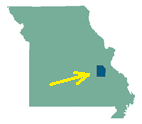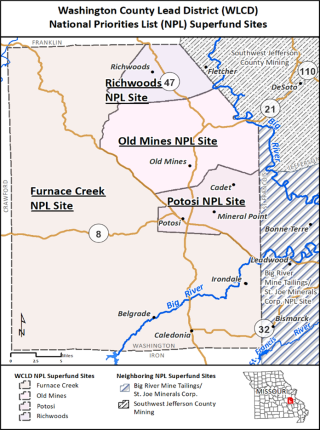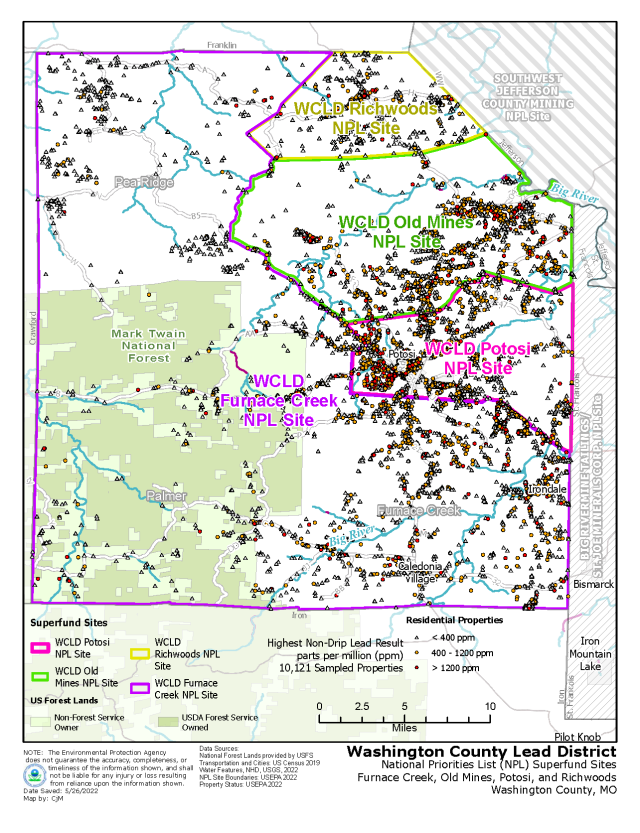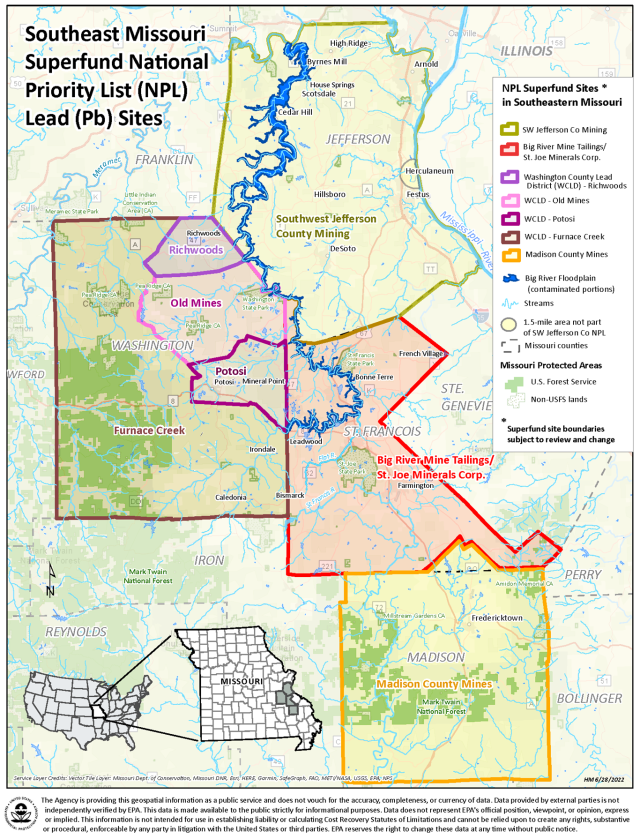Washington County Lead District National Priority List (NPL) Superfund Sites, Washington County, Missouri – Fact Sheet, July 2022
Proposed Plans for Drinking Water Wells – Public Comment Opportunity and Public Meetings
Introduction

The U.S. Environmental Protection Agency (EPA) Region 7 is seeking public input on four Proposed Plans (plans) to address lead and other heavy metal contamination in private, domestic drinking water wells at residential properties within the Washington County Lead District (WCLD) National Priorities List (NPL) Superfund Sites. The four NPL Superfund Sites covering the Washington County Lead District include: Furnace Creek, Old Mines, Potosi and Richwoods. (See three site maps at right.)
Each Proposed Plan is similar, but tailored to the history, data and investigations performed at each NPL site. EPA’s plans summarize potential cleanup options (also known as alternatives) for how to best address lead contamination in private, domestic drinking water wells at the sites.

EPA’s recommendation for the preferred cleanup is Alternative 4: Point-of-Use Treatment Systems with Institutional Controls and Health Education.
Under this cleanup alternative, residential properties at the site that utilize private wells with lead, cadmium, arsenic, or barium contamination will be eligible for the installation of Point-of-Use (POU) water filtration units. They are also known as drinking water filters. There are several types of POU units to remove lead from the drinking water. Drinking water filters will need to be changed to properly maintain the system to meet health-based standards for drinking water. Lead is the primary contaminant of concern at these sites, although cadmium, arsenic and barium may be elevated in some wells.
Public Comment Period Overview
Public comments on the Proposed Plans will be accepted from Tuesday, July 19, 2022, through Thursday, Aug. 18, 2022. Upon timely request, the comment period can be extended by an additional 15 days. On July 19, the Proposed Plans and Administrative Record files (AR files) for these actions will be published online for public review at the following Site Profile Pages (see Site Documents & Data):
Public MeetingsOn Thursday, July 21, from 6 to 7:30 p.m., EPA will hold a VIRTUAL PUBLIC MEETING to share information and offer an opportunity for the public to provide comments on the Proposed Plans for the WCLD sites. The event will be hosted by EPA with a presentation at 6 p.m., followed by an opportunity for oral and written comments to be transcribed into the record. At the time of the event, please click on any of the four Site Profile Page links above (check links for updates). To register, click here to visit the Zoom website. On Monday, July 25, 2022, from 5:30 to 7 p.m., EPA will hold an IN-PERSON PUBLIC MEETING at the Washington County Library, Lower Level, 235 E. High St., Potosi, MO 63664. EPA will deliver a presentation at 5:30 p.m., followed by an opportunity for oral and written comments about the plans for the WCLD sites to be transcribed into the record (check links above for updates). |
How to Comment

Written comments, questions about the plan, or requests for site information can be directed to:
Elizabeth Kramer
Community Involvement Coordinator
U.S. EPA Region 7 (ORA/OPA)
11201 Renner Boulevard
Lenexa, KS 66219
Phone: 913-551-7186
Toll-free: 1-800-223-0425
Email: [email protected]
EPA encourages community members to report any site concerns.
EPA is committed to providing reasonable accommodations to individuals with disabilities. Captioning will be provided during the virtual event. If you require special accommodations at either meeting, including live translation into a language other than English or other accommodations, please contact Elizabeth Kramer to make arrangements.
If you do not have internet access, the documents will also be available during normal business hours at the following locations:
Washington County Library
235 E. High Street
Potosi, MO 63664
573-438-4691
EPA Region 7 Records Center
11201 Renner Blvd.
Lenexa, KS 66219
1-800-223-0425
Copies of the plan can be mailed upon request and available at Washington County Library.
About Lead and Public Health

Lead is a toxic metal that is harmful if inhaled or swallowed and can pose serious health risks, particularly to children under 7 years old, as well as pregnant women and nursing mothers.
Children are more vulnerable to lead poisoning than adults because their nervous systems are still developing. Children can get lead into their bodies by putting their hands or toys in their mouths after touching lead-contaminated soil and dust. Children can be exposed to lead in their environment and before birth from lead in their mother’s body. At lower levels of exposure, lead can decrease mental development, especially learning, intelligence and behavior. Physical growth may also be decreased. A child who swallows large amounts of lead may develop anemia, severe stomachache, muscle weakness, and brain damage. Exposure to lead during pregnancy can also result in premature births. Some effects of lead poisoning in a child may continue into adulthood. Lead is classified by EPA as a probable human carcinogen and is a cumulative toxicant that affects multiple body systems.
It is important that children under 7 be tested annually, because lead-poisoned children do not always look or act sick. The only way to know if your child has elevated blood lead levels is to have his or her blood tested. Your doctor can do a simple blood test to check your child, or you, for lead exposure. Talk to your pediatrician, general physician, or local health agency about testing your child. To arrange for lead screening of your children, please contact the Washington County Health Department in Potosi at 573-438-2164. To learn more, visit their website.
Overview of Proposed Plans
The Proposed Plans include summaries of cleanup alternatives evaluated for eliminating exposure to contaminated water from private, domestic drinking water wells. Between 2005 and 2020, EPA collected 9,585 water samples from 4,538 properties. Health-based limits for lead, cadmium, arsenic or barium were exceeded at 625 properties, or 13.8% of residential properties sampled. EPA began providing alternative water to people with known contaminated wells in 2006, as part of a Removal Action.
EPA Region 7 is the lead agency for site activities, and the support agencies are the Missouri Department of Natural Resources (MoDNR) and the Missouri Department of Health and Senior Services (MDHSS). After reviewing and considering all information submitted during the 30-day public comment period and Public Meeting, EPA, in consultation with MoDNR, plans to develop Interim Records of Decision (IRODs). EPA needs community and state acceptance of the Proposed Plans to address contamination at each individual site. The IRODs will include Responsiveness Summaries that address all substantive public comments received during the public comment periods. Results of the interim remedial activities to address lead contamination in drinking water wells will be used to inform the final, future cleanup decision, or final Record of Decisions (ROD), for the sites.
The remedial alternatives being considered in these Proposed Plans are:
- Alternative 1: No Action – This alternative is included to use as a baseline for comparison to other alternatives and is required by regulation.
- Alternative 2: Bottled Water Service with Institutional Controls and Health Education – This alternative includes providing bottled water, as well as potential institutional controls and health education.
- Alternative 3: Whole-House Treatment Systems - Ion Exchange with Institutional Controls and Health Education – This alternative includes installing treatment systems in an entire residence, along with institutional controls and health education.
- Alternative 4: Point-of-Use Treatment Systems with Institutional Controls and Health Education – This alternative includes installing Point-of-Use Treatment Systems installed at the kitchen tap in individual residences, as well as institutional controls and health education.
- Alternative 5: Extend Existing Public Water Supply – This alternative is a limited option for extending existing community public water system service to residences located within a 1-mile distance from public water systems, as well as institutional controls and health education. This alternative is not a stand-alone option, but may be included as an addition to Alternatives 2 to 4. This alternative is not included in the Richwoods Proposed Plan because there are no community public water systems at the Richwoods Site.
EPA’s preferred alternative is Alternative 4: Point-of-Use Treatment Systems with Institutional Controls and Health Education.
Site Background
See the recently published Fact Sheet and infographics online and the related Public Notice.
Technical Assistance Grant
In an effort to help affected communities understand the technical information related to a Superfund site, EPA has established a Technical Assistance Grant (TAG) Program. The program provides up to $50,000 for a qualified citizens’ group to hire an independent technical advisor. The advisor can assist citizens in their interpretation of technical data, site hazards, and the different scientific technologies used to support site actions.
Information Repository and Administrative Record Available
Site project information is available to the public at web repositories. The Administrative Record (AR) is the official site file that contains technical documents with respect to response actions. EPA has developed document collections to form a clear understanding of the decisions to take actions at the site. To view the Proposed Plans, cleanup documents, including the ARs for the sites (Furnace Creek, Old Mines, Potosi and Richwoods), visit these Site Profile Pages (see Site Documents & Data):
Additional Information
For more information about lead, visit:
- EPA's Lead page
- EPA's Learn About Lead page
- EPA's Lead at Superfund Sites page
- EPA's Fight Lead Poisoning With a Healthy Diet page
- EPA’s Protect Your Family From Lead in Your Home
- CDC’s Lead page
- ATSDR ToxFAQs™
- For more information about ways to protect your family, see Healthy Homes Fact Sheets online.
- Fact Sheets for Missouri cleanup sites are online.
EPA Contact Information
EPA encourages community members to ask questions and report any concerns about this site. Questions, comments, or requests for site information can be submitted to EPA:
Elizabeth Kramer
Community Involvement Coordinator
U.S. EPA Region 7 (ORA/OPA)
11201 Renner Boulevard
Lenexa, KS 66219
Phone: 913-551-7186
Toll-free: 1-800-223-0425
Email: [email protected]
